
Binh Phuoc, approximately 120 km from Ho Chi Minh City, serves as a vital link connecting the Central Highlands with the Mekong Delta and Cambodia.
There are two distinct seasons to experience in Binh Phuoc: the rainy season from May to October and the dry season from November to April.
The province's most beautiful time is late December to January when the sun shines bright, turning rubber forests orange and yellow. Colorful cashew gardens dot the landscape. In March and early April, coffee flowers bloom, adding white blossoms to the scenery.
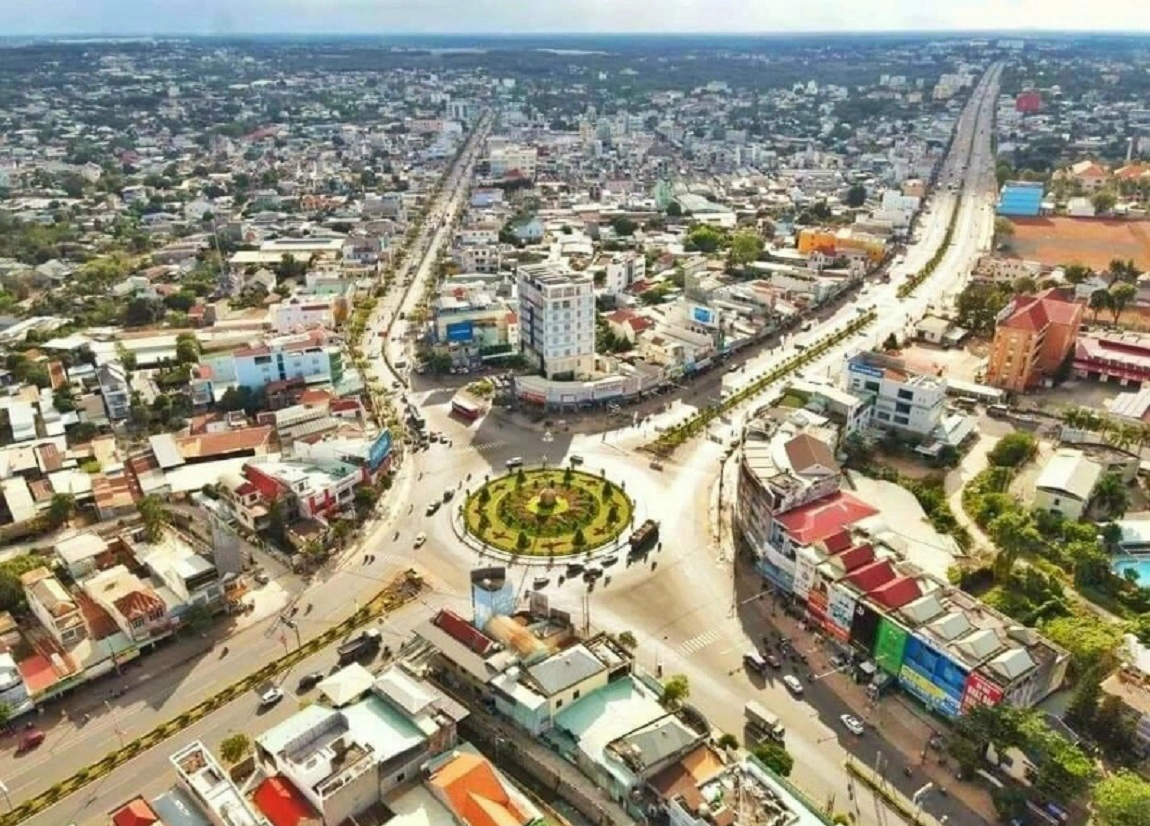
Dong Xoai City, the capital of Binh Phuoc Province, seen from above. Photo courtesy of Dong Xoai official website
There are many places to explore within approximately 80 kilometers from the province's capital city Dong Xoai. The region has stunning natural beauty, including waterfalls, national parks, a rich indigenous culture, and historical landmarks. To fully immerse yourself in these attractions, it's advisable to plan a tour spanning at least three days and two nights, or even longer.
Bu Gia Map National Park
Bu Gia Map National Park is located in the northeastern part of Binh Phuoc Province, approximately 90 km from Dong Xoai City. This national park lies in the lowlands of the southern Central Highlands, with its highest peak reaching 700 meters above sea level. Apart from harboring a wealth of rare genetic species and diverse flora and fauna, Bu Gia Map National Park serves as an ideal destination for adventure enthusiasts and those who appreciate the untouched beauty of the wild.
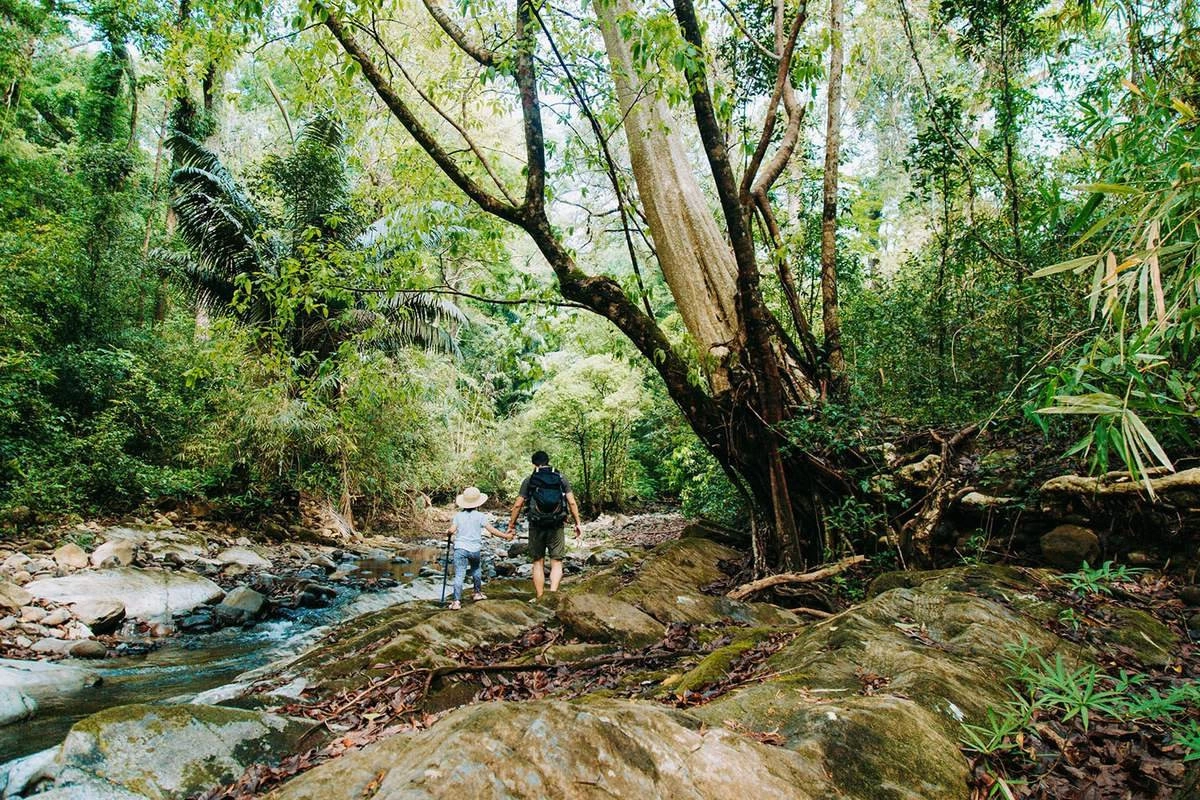
To truly explore Bu Gia Map National Park, plan for a two-day, one-night adventure. This time frame allows you to visit attractions like Dak Mai Waterfall and Hoa Mai Lake. The evening offers opportunities for cultural exchanges, sampling unique S'tieng dishes, and even going night hunting in the forest.
Ba Ra Mountain
Ba Ra Mountain, rising 730 meters above sea level, ranks as the third highest peak in the south. Located in Son Giang Ward, Phuoc Long Town, it is about 50 kilometers from Dong Xoai City and is a favored trekking destination. The S’tieng people call it "Bonom Brah," which means "God Mountain."
The air is crisp, and the scenery is breathtaking. From the mountaintop, visitors can gaze upon the surrounding areas and Mo Waterfall at the mountain’s base.
Rubber forest

Binh Phuoc, renowned as Vietnam’s rubber capital, boasts an abundance of rubber forests. These forests intermingle with young and old woodlands, creating a picturesque landscape filled with shades of green, dark green, and yellow.
Year-end visits are perfect for picnics amidst thick, soft carpets of fallen leaves, where you can watch the golden leaves gracefully descend and capture beautiful photographs.
Son Loc Pagoda
Son Loc Pagoda, located in Son Loc Hamlet, Loc Khanh Commune, Loc Ninh District, about 10 kilometers from the center of Loc Ninh Town, is the oldest Khmer temple in Binh Phuoc, constructed in 1931 and spanning an area of more than 1,200 square meters.
A visit to the pagoda provides insight into the spiritual life of the locals and opportunities to partake in various cultural activities and traditional Khmer festivals. The pagoda offers the chance to experience Khmer customs, traditions, religion, and cultural heritage.
Bom Bo Village
Bom Bo Village is located in Binh Minh Commune, Bu Dang District. To reach the destination from Dong Xoai City, follow National Highway 14 towards Bu Dang, roughly 50 kilometers away. Soc Bom Bo, with the rhythmic sounds of rice pounding by the S'tieng people, has etched itself into poetry and history.
In this place, visitors have the opportunity to immerse themselves in S'tieng culture, evoking memories of days gone by through the sounds of gongs and rice-pounding pestles. The surroundings, with traditional longhouses, reconstructed villages, and local cuisine, complete the nostalgic experience.
Ta Thiet Base
Ta Thiet Base, once served as the headquarters for the Liberation Army of South Vietnam, is a national historical site in Loc Thanh Commune, Loc Ninh District, covering an area of 3,500 hectares. During the resistance against the French and Americans, this base served as a key assembly point for troops traveling from North to South in preparation for the Ho Chi Minh Campaign. It was built with a network of tunnels, trenches, workshops, and robust training and combat facilities.
Ta Thiet Base remains a revolutionary landmark and a popular tourist destination for both locals and visitors from across the nation.
My Le Ecotourism Area
Covering an area of around 50 hectares in Long Hung Commune, Phu Rieng District, the My Le Ecotourism Area offers a landscape nestled between mountains, hills and lakes. It is located about 30 kilometers from Dong Xoai City and provides hands-on experiences at fruit orchards and oolong tea hills. During harvest seasons, visitors can pick a variety of fruits such as rambutans, grapefruits, mangosteens, and more. Travelers can also take a train ride to enjoy the tea hills while exploring the animal garden.
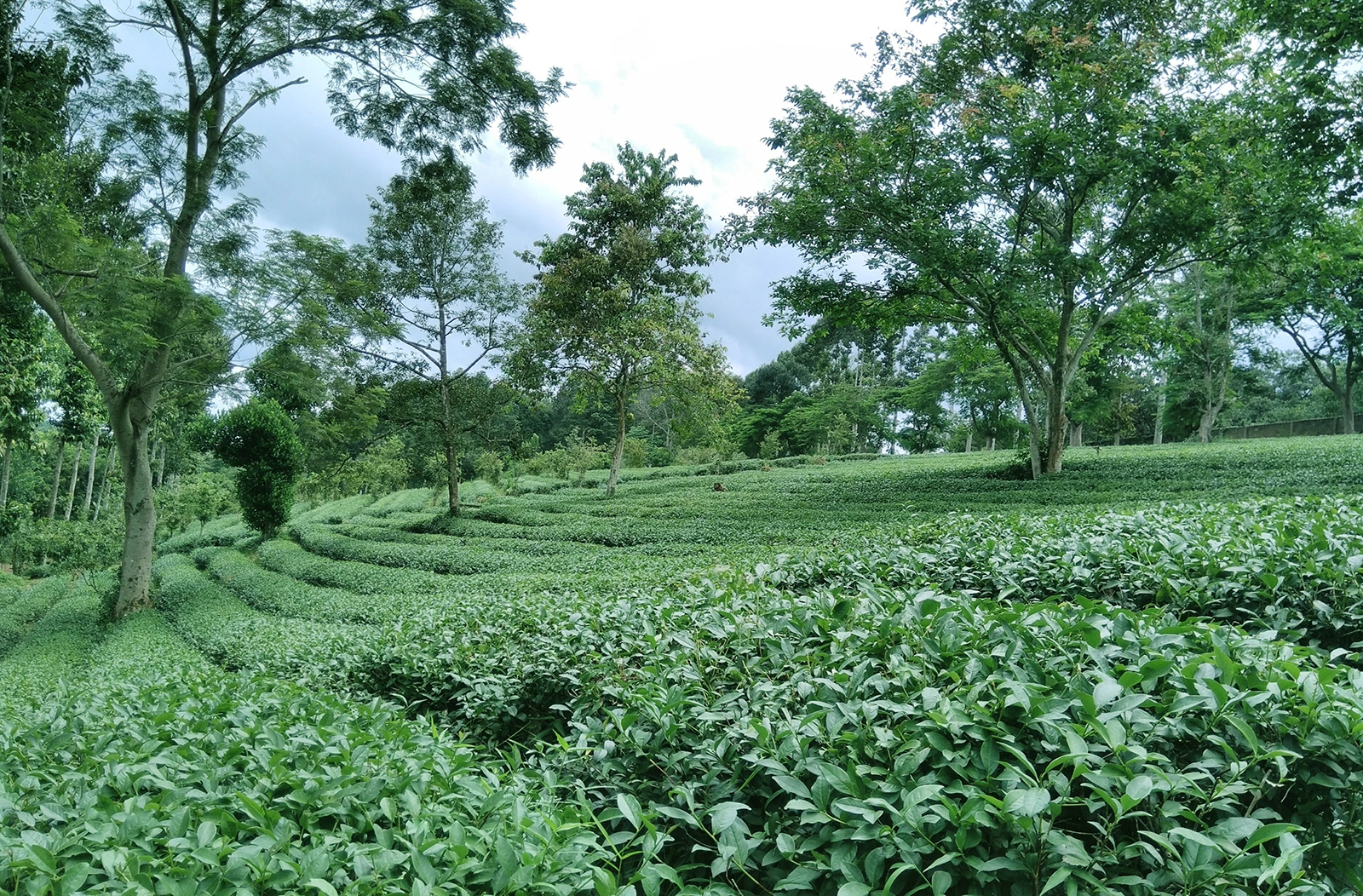
Bu Lach Grassland
The Bu Lach Grasslands, situated in Dong Nai Commune, Bu Dang District, cover about 500 hectares, nestled between mountains, forests, waterfalls, and streams. In the middle of the grasslands lies a large lake, surrounded by vast primeval forests.
"Lach" in the local M’nong language means glade, and the lake in the glade gives it the name "Bau Lach" or "Bu Lach." Visitors to this site can marvel at the lush grasslands adorned with purple myrtle flowers, surrounded by the songs of wild birds. The area is currently slated for eco-tourism development in the near future.
Can Don Hydroelectric Lake
This hydroelectric lake bed, when viewed from above, resembles a winding dragon. The Can Don Hydropower Lake is a water storage and electricity generation project on the Be River system, and it primarily feeds Thac Mo Hydropower. With its extensive lake area and stunning flooded forest landscape, this location has given rise to lakeside tourism and fishing industries.
Yen Son Ha Island Tourist Area
Yen Son Ha Island, situated in Tan Phu Town, Dong Phu District, covers approximately 10 hectares and is blanketed in lush forests, creating a refreshing atmosphere. Beyond the natural beauty, this area offers a wide range of activities suitable for tourists, including swimming pools, visits to salangane islands and lagoons by canoe or boat rides, and visits to the statue garden and cultural heritage gallery.
The waterfalls
Elephant Waterfall (Voi Waterfall)
Elephant Waterfall is approximately 15 meters tall, and is found within the Bu Lach grassland ecological complex. The name comes from the history of the area where numerous elephant bones once formed hills. The journey to Voi Waterfall involves a narrow, bumpy road along hilly terrain, but the reward is a visit to a poetic and romantic spot.
Dak Mai Waterfall
Dak Mai Waterfall spans about 50 meters in width and 12 meters in height, requiring a trek through steep hills to reach it. The water surface features a layer of rocks smoothed by the force of the waterfall.

Dung Waterfall (Standing Waterfall)
Dung Waterfall is considered one of the most beautiful waterfalls in the province. It stands at a height of approximately 5-6 meters and spans about 10 meters in width, with a rapid, powerful flow that generates white foam cascades over the rocks. Below the waterfall, you'll find an abundance of sizable rocks, flanked by grassy beds and a canopy of trees on both sides. These rocks are arranged to create a pathway, allowing visitors to traverse to either side of the river on days when the water flow is gentler.
Quang Minh Pagoda
Quang Minh Pagoda stands atop a raised mound and features a grand entrance with neo-classical architectural elements. Located on Highway 14, in the heart of Tan Dong Ward, Dong Xoai City, this pagoda was built around 1950 and underwent restoration in 1990.
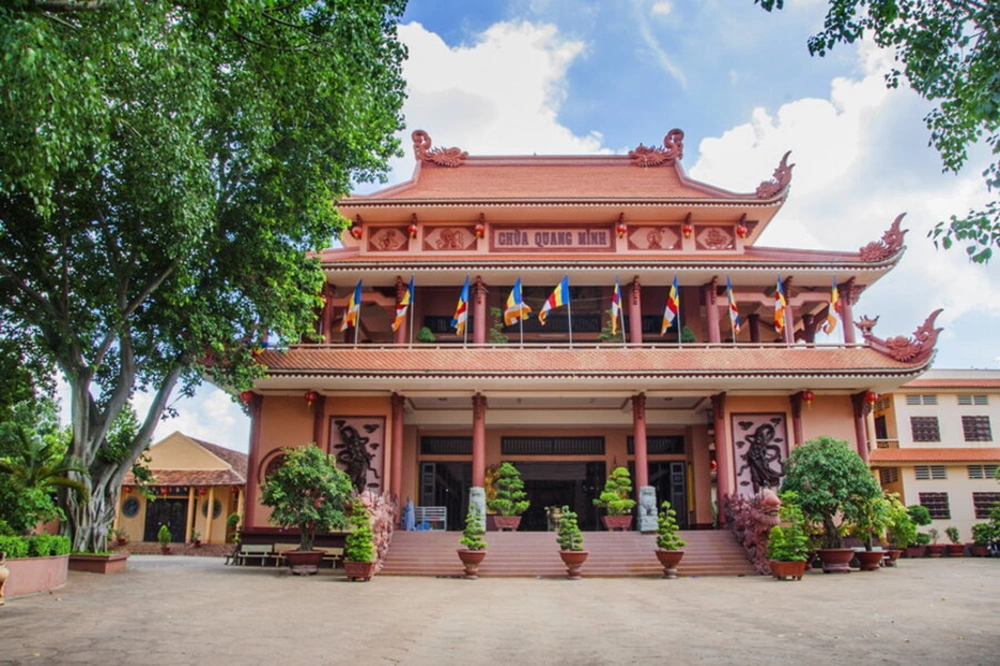
The pagoda makes an impression with its ancient aesthetics, marked by distinct red-tiled roofs. At the pinnacle of the Quang Minh Pagoda is a large bell, symbolizing the belief that tolling brings tranquility and harmony to all.
Free-range pork
Free-range pork is a specialty hailing from Bom Bo Village. It is raised without using processed foods, resulting in lean and tender meat.
Often savored by the S’tieng people, this pork can be prepared in various ways, including grilling, braising, and steaming. Grilled pork, served with unripe bananas and wild vegetables, is a beloved choice.
Cashew salad
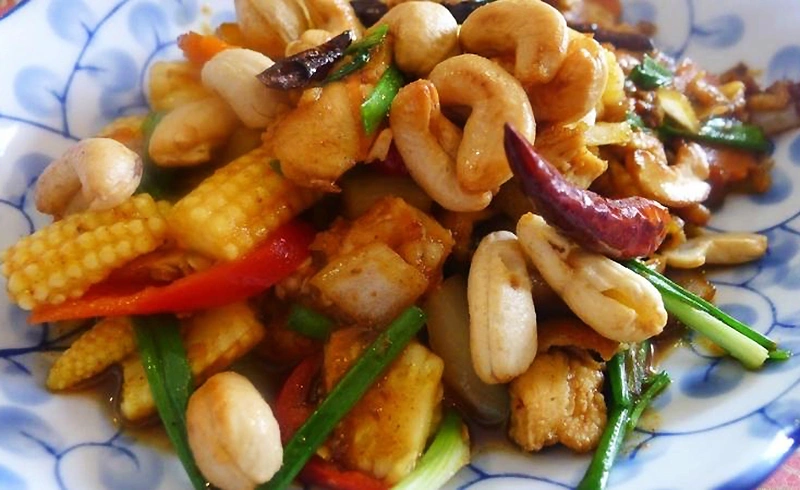
Cashew salad entices diners with its appealing colors. Photo by VnExpress/Nguyen Nam
Cashew salad is a must-try dish in Binh Phuoc, where cashew nuts replace peanuts in a blend with pork belly, shrimp, and fragrant herbs. This dish offers a balanced and refreshing flavor.
Cashew salad is a popular dish with prices ranging from VND30,000 to VND50,000 ($1.24 to $2), depending on the eatery.
Bamboo tube rice
Bamboo tube rice is a staple dish among Binh Phuoc's diverse ethnic groups. Glutinous rice is cooked inside bamboo tubes, often mixed with beans to enhance the flavor. The choice of bamboo for cooking should be neither too young or over-mature.
After cooking and cooling, the tube is peeled. To savor, diners can simply cut the rice into small pieces and dip it in peanut salt and sesame salt. The rice has the natural sweetness infused with the aroma of bamboo.
Rattan and fish noodle soup
The rattan and fish noodle soup takes its distinctive character from the slight bitterness of rattan buds. Rattan buds are not tough but have a pleasant, crispy texture. They leave a lingering taste that's both slightly bitter, sweet, and refreshing.
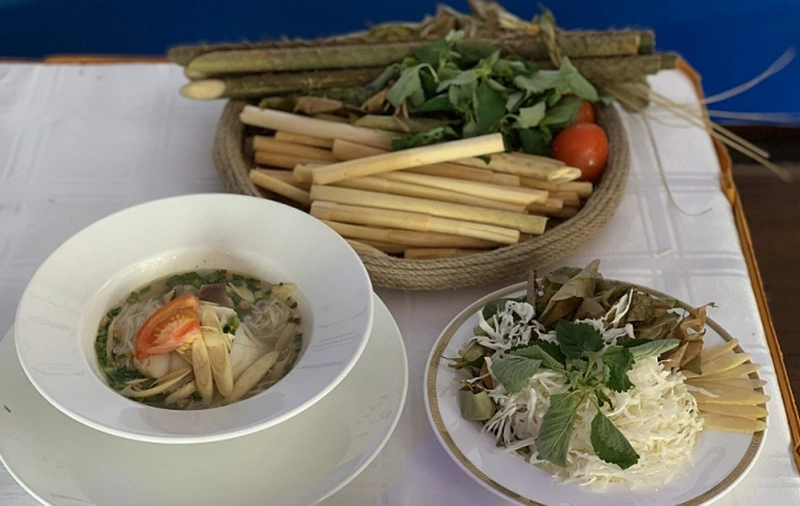
When indulging in this dish, it's essential to pair it with water spinach and cabbage, and a dash of green chili to complement the rich fish flavor. The crispness of fresh cabbage and the fleshy taste of water spinach balance out the dish, reducing any heaviness.
Milk cicadas
Considered a rare and unique delicacy, milk cicadas are gathered and transformed into delectable dishes for guests. These cicadas thrive during the summer on cashew and rambutan trees. When night falls, they undergo a transformation from larvae to adults.
These molting cicadas, known as milk cicadas, are collected and typically cooked in porridge, fried in flour, stir-fried with onions, but they are at their best when crispy-fried.
After capturing the cicadas, they are put into a tightly sealed bag, and rinsed in a diluted saltwater solution to prevent them from growing wings and escaping. The cicadas are then dipped in boiling water and then rinsed with cold water to eliminate any potential toxins.
The cicadas are gently fried in hot oil. Once they turn golden brown, they are ready to be served. These cicadas emit a delightful aroma and are typically accompanied by fresh herbs. Diners often enjoy them by dipping them in garlic and chili fish sauce.
Coffee: Binh Phuoc is also known for its coffee, which is praised for its unique aroma and rich flavor. Visitors can acquire weasel coffee, pre-ground coffee, or whole bean coffee.
Tangerines: Tan Thanh tangerines offer a delightful combination of sweetness and a slight tangy undertone. They are cultivated using high-quality processes with minimal fertilizer and pesticides.
Jackfruit: Binh Phuoc is also renowned for its jackfruit, with jackfruit from Loc Ninh District being a standout variety, known for its bountiful yield and fragrant citrus notes.
Binh Phuoc is traversed by National Highways 13 and 14, providing various transportation options to reach the province. Visitors can choose their mode of travel based on destination and point of departure.
For bus travel from Ho Chi Minh City to Binh Phuoc, departing from the Mien Dong (Eastern Region) Bus Station, routes are available to Dong Xoai City, Phu Rieng District, Bu Dang District, Phuoc Long Town, and Bu Gia Map District.
Several bus companies, including Thanh Cong, Kim Manh hung, Mai Huy Thanh, and Petro Binh Phuoc, offer these routes.
If you’re headed to Loc Ninh District, Binh Long Town, Chon Thanh Town, Hon Quan District, or Bu Dop District, bus companies like Hoang Yen, Ut Linh, Thien Bao Phuc, and Nhat Truong are available. Bus ticket prices range from VND100,000 to VND180,000 ($4 to $7) per person, with a travel time of about 3 to 4 hours.
For those who prefer a flexible schedule and the freedom to stop and rest as needed, personal cars, motorbikes, or rented private cars from Ho Chi Minh City offer convenient routes. You can take Highway 14 to Dong Xoai or Highway 13 to reach destinations like Loc Ninh, Binh Long, and Hon Quan.
Well-regarded establishments include Bom Bo Hotel, An Loc Spa & Hotel, and My Le. Room prices in these establishments generally range from VND550,000 to around VND3.4 million ($22 to $138) per night.
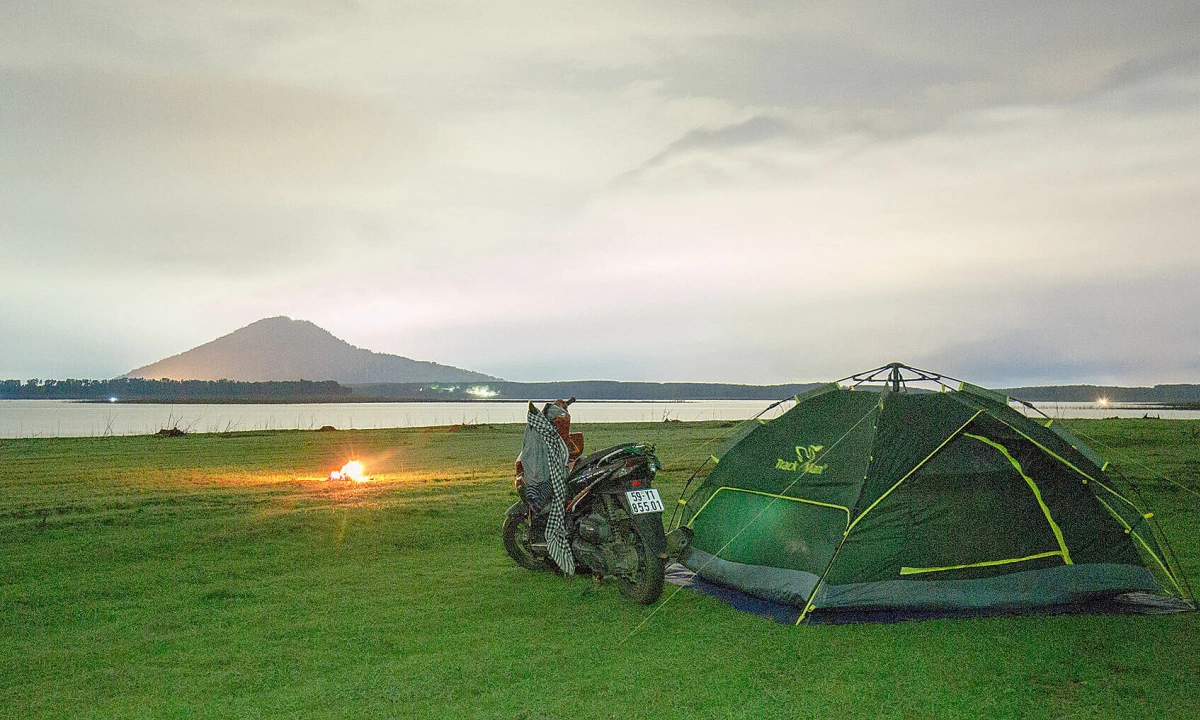
Additionally, there are motels and 1-2 star hotels in Dong Xoai City with prices ranging from VND150,000 to VND500,000 per night.
For those seeking a more immersive experience in nature, you can contact the Center for Propaganda, Tourism and Conservation Rescue of Bu Gia Map National Park to book accommodation services, which may include rooms or camping in the heart of the forest. Accommodation in this natural setting costs VND100,000 per person per night.
Story by Nguyen Nam